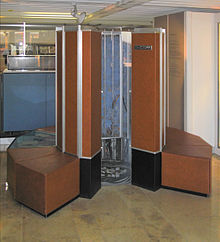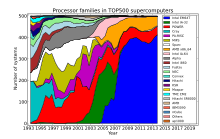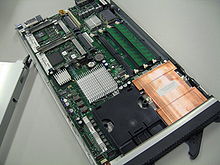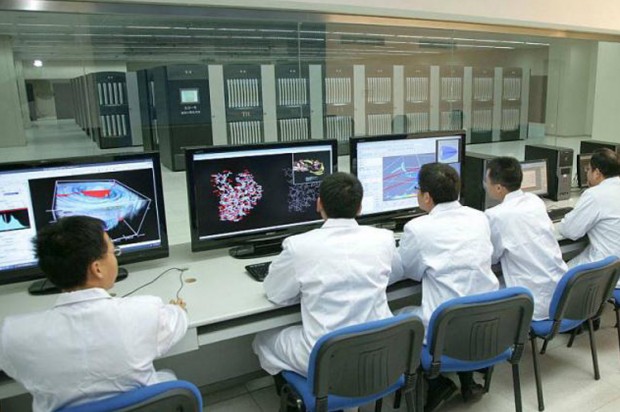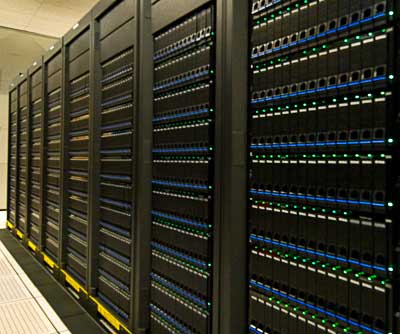
SUPERCOMPUTER
REMEMBER THE MOVIE 2001 AND HAL
Dee Finney's blog
start date July 20, 2011
today's date April 27, 2014
page 671
TOPIC: THE WORLD'S SUPER COMPUTER
NOTE: WHEN I FIRST HEARD ABOUT THIS SUPER COMPUTER - I THOUGHT -
CERTAINLY CHINA WOULD HAVE IT. THE UNITED STATES NO LONGER IS TOP DOG
INTERESTING VIDEO - HOWEVER - WHOEVER OPERATED THIS COMPUTER CAN'T SPELL.
https://www.youtube.com/watch?v=Vz7_oCrBzB4
The 'Unal Center of Education, Research & Development'
(UCERD) is based on the theme of carrying out research and education in the
areas of Computer Science, Electrical and Mechanical Systems. The mission of
UCERD is to investigate, develop and manage computer technology in order to
facilitate scientific progress. With this aim, special dedication has been
awarded to areas such as Computers, Telecomm and Mechanical Applications in
Science and Engineering. All these activities are complementary to each other
and very tightly related. The primary objective of UCERD is to build
multidisciplinary setup that facilitates industrial and scientific academic
practices to improve their understanding of needs and to help them in focusing
on the basic research.
The UCERD is further categorized into following groups:
Research
& Studies
UCERD research group motivates people to study confirmed facts and explore to
collect or view more knowledge and provide beneficial information that enrich
the mind. It continually upgrade knowledge and achieve improvement to what we
currently have to satisfy the human desire to "know".
The importance of research and knowledge in Islam can be determine by this fact
that the very first verses of Quran revealed to the Holy Prophet are about
research knowledge.
The Quran says: "Read! In the name of thy Lord and Cherisher
Who created. Created man out (mere) clot of congealed blood. Read! and thy Lord
is Most Bountiful. He Who taught (the use of) the Pen. Taught man that which he
knew not." The Quran asks: "Are those equal, those who know and those who do not
know? "
The Hadith (sayings of Prophet Peace be upon him) literature is also full of
references to the importance of knowledge. The Messenger of God (Peace be upon
him) said: 'Seek knowledge from the cradle to the grave.' The Prophet Muhammad
(Peace be upon him) said: 'Seeking of knowledge is the duty of every man and
woman.'
Projects
UCERD Project Channel provides practical experience using scientific method and
helps to stimulate interest in scientific inquiry. The outcome of a UCERD
professional and investigatory project involves a discovery that can improve
the lives of people and improve their life style.
Technology News Channel
As society is developing more, advance means of communication are required.
UCERD TechNews channel plays an important role to keep people informed about
latest technologies.
UCERD Team
UCERD is working and searching more collaboration between institutions, research
groups across different disciplines, between researchers from academia and
industry, between International and local organization. The Studies, Research &
Development carried out by the UCERD is organized in several research groups.
Their research and development work is published in international conferences
and journals.
UCERD People
UCERD Research & Development Team is finding friendly
technologies to fulfill human needs so that science and
humanity go on.
| Hussain Cheema |
hussain.tassadaq@gmail.com |
Tassadaq
Hussain received his Masters degree in Electronics
for Systems from the Institut supérieur
d’électronique de Paris in 2009. Currently he is
doing Ph.D. degree in Computer Architecture from UPC
. For the period of the PhD he is working as a
research student with the Computer Sciences group at
the Microsoft Barcelona Supercomputing Center (BSC).
The group is responsible to investigate and evolve
high performance computing systems for data and
compute bound applications. Mostly the group’s
research is focused on Shared Memory Multiprocessor
Architectures, Clustered Computing, Reconfigurable
Computing, Multi/Many Core Architectures,
Heterogeneous Architectures, Transactional Memories,
ISA (Instruction Set Architecture) virtualizations,
Microprocessor Micro-architectures and Software
Instrumentation & Profiling.
Tassadaq’s research focuses on studying the use of
accelerators for supercomputing purposes. The main
focus is to schedule multi-accelerator/vecotor
processor data movement in hardware. At the
theoretical level we are proposing novel
architectures for the acceleration of HPC
applications |
| Laeeq Ahmad |
laeeq@ucerd.com |
| Laeeq
earned a Bachelor of Science in Electrical
Engineering specialization in Telecommunication
Studies from Riphah International University. Laeeq
Ahmad has worked in Telecommunication Department
since 2005. In 2005 Laeeq enlisted into the Huawei
Telecom. He has been working for 7 years in several
leading and diverse organizations in senior
leadership positions.As Member of the Grop Lead his
responsibilities include, providing IT Management
Assurance and Knowledge Management |
| Faisal |
faysal@ucerd.com |
| Mr. Faisal
has experience of High speed and RF PCB designing
with Emphases of Signal and Power integrity, EMC and
Thermal analysis since 2004. He has experience on
designing closed loop servo motor control system for
robotic applications. |
|
Farooq Riaz Malhi |
Mobilink Pakistan
farooq.riaz@mobilink.net |
| Mr Farooq
Riaz is a Telecom Engineer of Mobilink Networks. He
got a bachelor’s degree in Electrical Engineering
with specialization in Electronics and
Communications in 2005. For last 5 years, he is in
the field of telecommunications. Currently he is
working as Team Lead (Fiber Optics Operations) in
PMCL-Mobilink Pakistan. He has extensive experience
of OSP issues and also had Network Management
training from Hauwei University, China. |
|
Safwan Mehboob Qureshi |
safwanmehboob@hotmail.com |
| Mr Safwan
has diverse experience of telecommunication, started
from the installation, upgrade and ended up in Level
3 & 4 support for TETRA communication. |
|
Uzma Siddique |
Researcher: Wireless
Comm, University of Manitoba, Canada
siddiquu@ee.umanitoba.ca |
| Uzma
expertise are in field of Telecommunications to
formulate joint scheduling and resource allocation
problems and power control problem and to design
procedures/algorithms for Multi-tier OFDMA based
networks Uplink and Downlink taking into account the
single Cell and Multicell scenarios. |
Supercomputer is
a computer at
the frontline of contemporary processing capacity – particularly speed of
calculation which can happen at speeds of nanoseconds.
Supercomputers were introduced in the 1960s, made initially and, for decades,
primarily by Seymour
Cray at Control
Data Corporation (CDC), Cray
Research and subsequent companies
bearing his name or monogram. While the supercomputers of the 1970s used only a
few processors,
in the 1990s machines with thousands of processors began to appear and, by the
end of the 20th century, massively
parallelsupercomputers with tens of thousands of "off-the-shelf" processors
were the norm. As of November 2013,
China's Tianhe-2 supercomputer
is the fastest
in the world at 33.86 petaFLOPS,
or 33.86 quadrillion floating point operations per second.
Systems with massive numbers of processors generally take one of two paths: In
one approach (e.g., in distributed
computing), a large number of discrete computers (e.g.,laptops)
distributed across a network (e.g., the Internet)
devote some or all of their time to solving a common problem; each individual
computer (client) receives and completes many small tasks, reporting the results
to a central server which integrates the task results from all the clients into
the overall solution. In another
approach, a large number of dedicated processors are placed in close proximity
to each other (e.g. in a computer
cluster); this saves considerable time moving data around and makes it
possible for the processors to work together (rather than on separate tasks),
for example in mesh and hypercube architectures.
The use of multi-core
processors combined with centralization is
an emerging trend; one can think of this as a small cluster (the multicore
processor in a smartphone, tablet,
laptop, etc.) that both depends upon and contributes to the
cloud.
Supercomputers play an important role in the field of computational
science, and are used for a wide range of computationally intensive tasks in
various fields, including quantum
mechanics, weather
forecasting, climate
research, oil
and gas exploration, molecular
modeling(computing the structures and properties of chemical compounds,
biological macromolecules,
polymers, and crystals), and physical simulations (such as simulations of the
early moments of the universe, airplane and spacecraft aerodynamics, the
detonation of nuclear
weapons, and nuclear
fusion). Throughout their history, they have been essential in the field of cryptanalysis.
History
The history of supercomputing goes back to the 1960s, with the Atlas at
the University
of Manchester and a series of
computers at Control
Data Corporation (CDC), designed
by Seymour
Cray. These used innovative designs and parallelism to achieve superior
computational peak performance.
The Atlas was
a joint venture between Ferranti and
the Manchester University and was designed to operate at processing speeds
approaching one microsecond per instruction, about one million instructions per
second. The first Atlas was
officially commissioned on 7 December 1962 as one of the world's first
supercomputers – considered to be the most powerful computer in the world at
that time by a considerable margin, and equivalent to four IBM
7094s.
The CDC
6600, released in 1964, was designed by Cray to be the fastest in the world
by a large margin. Cray switched from germanium to silicon transistors, which he
ran very fast, solving the overheating problem by introducing refrigeration. Given
that the 6600 outran all computers of the time by about 10 times, it was dubbed
a supercomputer and
defined the supercomputing market when one hundred computers were sold at $8
million each.
Cray left CDC in 1972 to form his own company. Four
years after leaving CDC, Cray delivered the 80 MHz Cray
1 in 1976, and it became one of
the most successful supercomputers in history. The Cray-2 released
in 1985 was an 8 processor liquid
cooledcomputer and Fluorinert was
pumped through it as it operated. It performed at 1.9 gigaflops and
was the world's fastest until 1990.
While the supercomputers of the 1980s used only a few processors, in the 1990s,
machines with thousands of processors began to appear both in the United States
and in Japan, setting new computational performance records. Fujitsu's Numerical
Wind Tunnelsupercomputer used 166 vector processors to gain the top spot in
1994 with a peak speed of 1.7 gigaflops per
processor. TheHitachi
SR2201 obtained a peak
performance of 600 gigaflops in 1996 by using 2048 processors connected via a
fast three-dimensionalcrossbar network.The Intel
Paragon could have 1000 to 4000 Intel
i860 processors in various
configurations, and was ranked the fastest in the world in 1993. The Paragon was
a MIMD machine
which connected processors via a high speed two dimensional
mesh, allowing processes to execute on separate nodes; communicating via the Message
Passing Interface.
Hardware and
architecture
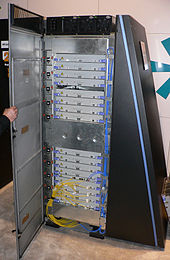
A
Blue
Gene/L cabinet showing the stacked
blades,
each holding many processors
Approaches to supercomputer
architecture have taken dramatic
turns since the earliest systems were introduced in the 1960s. Early
supercomputer architectures pioneered by Seymour
Cray relied on compact innovative
designs and local parallelism to
achieve superior computational peak performance.However, in time the demand for
increased computational power ushered in the age of massively
parallelsystems.
While the supercomputers of the 1970s used only a few processors,
in the 1990s, machines with thousands of processors began to appear and by the
end of the 20th century, massively parallel supercomputers with tens of
thousands of "off-the-shelf" processors were the norm. Supercomputers of the
21st century can use over 100,000 processors (some being graphic
units) connected by fast connections.
Throughout the decades, the management of heat
density has remained a key issue
for most centralized supercomputers. The
large amount of heat generated by a system may also have other effects, e.g.
reducing the lifetime of other system components. There
have been diverse approaches to heat management, from pumping Fluorinert through
the system, to a hybrid liquid-air cooling system or air cooling with normal air
conditioning temperatures.
Systems with a massive number of processors generally take one of two paths. In
the grid
computingapproach, the processing power of a large number of computers,
organised as distributed, diverse administrative domains, is opportunistically
used whenever a computer is available. In
another approach, a large number of processors are used in close proximity to
each other, e.g. in acomputer
cluster. In such a centralized massively
parallel system the speed and
flexibility of the interconnect becomes very important and modern supercomputers
have used various approaches ranging from enhanced Infiniband systems
to three-dimensional torus
interconnects. The use of multi-core
processors combined with
centralization is an emerging direction, e.g. as in the
Cyclops64 system.
As the price/performance of general
purpose graphic processors (GPGPUs)
has improved, a number of petaflop supercomputers
such as Tianhe-I and Nebulae have
started to rely on them. However,
other systems such as the K
computer continue to use
conventional processors such as SPARC-based
designs and the overall applicability of GPGPUs in
general purpose high performance computing applications has been the subject of
debate, in that while a GPGPU maybe tuned to score well on specific benchmarks
its overall applicability to everyday algorithms may be limited unless
significant effort is spent to tune the application towards it. However,
GPUs are gaining ground and in 2012 the Jaguar
supercomputer was transformed
into Titan by
replacing CPUs with GPUs.
A number of "special-purpose" systems have been designed, dedicated to a single
problem. This allows the use of specially programmedFPGA chips
or even custom VLSI chips,
allowing better price/performance ratios by sacrificing generality. Examples of
special-purpose supercomputers include Belle, Deep
Blue, and Hydra, for
playing chess, Gravity
Pipe for astrophysics, MDGRAPE-3 for
protein structure computation molecular dynamics and Deep
Crack, for breaking the DES cipher.
Energy usage and
heat management
A typical supercomputer consumes large amounts of electrical power, almost all
of which is converted into heat, requiring cooling. For example, Tianhe-1A consumes
4.04 Megawatts of electricity. The
cost to power and cool the system can be significant, e.g. 4MW at $0.10/kWh is
$400 an hour or about $3.5 million per year.
Heat management is a major issue in complex electronic devices, and affects
powerful computer systems in various ways. The thermal
design power and CPU
power dissipation issues in
supercomputing surpass those of traditional computer
cooling technologies. The
supercomputing awards for green
computing reflect this issue.
The packing of thousands of processors together inevitably generates significant
amounts of heat
density that need to be dealt
with. The Cray
2 was liquid
cooled, and used a Fluorinert "cooling
waterfall" which was forced through the modules under pressure. However,
the submerged liquid cooling approach was not practical for the multi-cabinet
systems based on off-the-shelf processors, and in System
X a special cooling system that
combined air conditioning with liquid cooling was developed in conjunction with
the Liebert
company.
In the Blue
Gene system IBM deliberately used
low power processors to deal with heat density. On
the other hand, the IBM Power
775, released in 2011, has closely packed elements that require water
cooling. The IBM Aquasar system,
on the other hand uses hot water
cooling to achieve energy
efficiency, the water being used to heat buildings as well.
The energy efficiency of computer systems is generally measured in terms of
"FLOPS per Watt". In 2008 IBM's
Roadrunner operated at 376 MFLOPS/Watt. In
November 2010, the Blue
Gene/Q reached 1684 MFLOPS/Watt. In
June 2011 the top 2 spots on theGreen
500 list were occupied by Blue
Gene machines in New York (one
achieving 2097 MFLOPS/W) with the DEGIMA
cluster in Nagasaki placing third
with 1375 MFLOPS/W.
Software and
system management
Operating systems
Since the end of the 20th century, supercomputer
operating systems have undergone
major transformations, based on the changes insupercomputer
architecture. While early
operating systems were custom tailored to each supercomputer to gain speed, the
trend has been to move away from in-house operating systems to the adaptation of
generic software such as Linux.
Since modern massively
parallel supercomputers typically
separate computations from other services by using multiple types of nodes,
they usually run different operating systems on different nodes, e.g. using a
small and efficient lightweight
kernel such as CNK or CNL on
compute nodes, but a larger system such as a Linux-derivative
on server and I/O nodes.
While in a traditional multi-user computer system job
scheduling is in effect a tasking problem
for processing and peripheral resources, in a massively parallel system, the job
management system needs to manage the allocation of both computational and
communication resources, as well as gracefully dealing with inevitable hardware
failures when tens of thousands of processors are present.
Although most modern supercomputers use the Linux operating
system, each manufacturer has its own specific Linux-derivative, and no industry
standard exists, partly due to the fact that the differences in hardware
architectures require changes to optimize the operating system to each hardware
design.
Software tools
and message passing
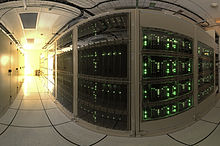
Wide-angle view of the
ALMAcorrelator.
[65]
The parallel architectures of supercomputers often dictate the use of special
programming techniques to exploit their speed. Software tools for distributed
processing include standard APIssuch
as MPI and PVM, VTL,
and open
source-based software solutions such as Beowulf.
In the most common scenario, environments such as PVM and MPI for
loosely connected clusters and OpenMP for
tightly coordinated shared memory machines are used. Significant effort is
required to optimize an algorithm for the interconnect characteristics of the
machine it will be run on; the aim is to prevent any of the CPUs from wasting
time waiting on data from other nodes.GPGPUs have
hundreds of processor cores and are programmed using programming models such as CUDA.
Moreover, it is quite difficult to debug and test parallel programs. Special
techniques need to be used for
testing and debugging such applications.
Distributed
supercomputing
Opportunistic approaches
Main article:
Grid
computing
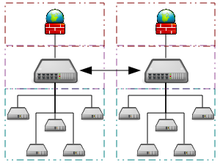
Example architecture of a
grid
computing system
connecting many personal computers over the internet
Opportunistic Supercomputing is a form of networked grid
computing whereby a “super
virtual computer” of many loosely
coupled volunteer computing
machines performs very large computing tasks. Grid computing has been applied to
a number of large-scale embarrassingly
parallelproblems that require supercomputing performance scales. However,
basic grid and cloud
computing approaches that rely on volunteer
computing can not handle
traditional supercomputing tasks such as fluid dynamic simulations.
The fastest grid computing system is the distributed
computing project Folding@home.
F@h reported 8.1 petaflops of x86 processing power as of March 2012. Of this,
5.8 petaflops are contributed by clients running on various GPUs, 1.7 petaflops
come from PlayStation
3 systems, and the rest from
various CPU systems.
The BOINC platform
hosts a number of distributed computing projects. As of May 2011, BOINC recorded
a processing power of over 5.5 petaflops through over 480,000 active computers
on the network[67] The
most active project (measured by computational power), MilkyWay@home,
reports processing power of over 700 teraflops through
over 33,000 active computers.
As of May 2011, GIMPS's distributed Mersenne
Prime search currently achieves
about 60 teraflops through over 25,000 registered computers. The Internet
PrimeNet Server supports GIMPS's
grid computing approach, one of the earliest and most successful grid computing
projects, since 1997.
Quasi-opportunistic approaches
Quasi-opportunistic supercomputing is a form of distributed
computing whereby the “super
virtual computer” of a large number of networked geographically disperse
computers performs huge processing power demanding computing tasks. Quasi-opportunistic
supercomputing aims to provide a higher quality of service than opportunistic
grid computing by achieving more
control over the assignment of tasks to distributed resources and the use of
intelligence about the availability and reliability of individual systems within
the supercomputing network. However, quasi-opportunistic distributed execution
of demanding parallel computing software in grids should be achieved through
implementation of grid-wise allocation agreements, co-allocation subsystems,
communication topology-aware allocation mechanisms, fault tolerant message
passing libraries and data pre-conditioning.
Performance measurement
Capability vs capacity
Supercomputers generally aim for the maximum in capability
computing rather than capacity
computing. Capability computing is typically thought of as using the maximum
computing power to solve a single large problem in the shortest amount of time.
Often a capability system is able to solve a problem of a size or complexity
that no other computer can, e.g. a very complex weather
simulationapplication.
Capacity computing in contrast is typically thought of as using efficient
cost-effective computing power to solve a small number of somewhat large
problems or a large number of small problems, e.g. many user access requests to
a database or a web site.Architectures that lend themselves to supporting many
users for routine everyday tasks may have a lot of capacity but are not
typically considered supercomputers, given that they do not solve a single very
complex problem.
Performance metrics
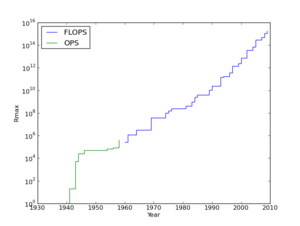
Top supercomputer speeds:
logscale speed over
60 years
In general, the speed of supercomputers is measured and benchmarked in
"FLOPS"
(FLoating Point Operations Per Second), and not in terms of MIPS,
i.e. as "instructions per second", as is the case with general purpose
computers. These measurements are
commonly used with an SI
prefix such as tera-,
combined into the shorthand "TFLOPS" (1012 FLOPS,
pronounced teraflops), or peta-,
combined into the shorthand "PFLOPS" (1015 FLOPS,
pronounced petaflops.) "Petascale"
supercomputers can process one quadrillion (1015)
(1000 trillion) FLOPS. Exascale is
computing performance in the exaflops range. An exaflop is one quintillion (1018)
FLOPS (one million teraflops).
No single number can reflect the overall performance of a computer system, yet
the goal of the Linpack benchmark is to approximate how fast the computer solves
numerical problems and it is widely used in the industry. The
FLOPS measurement is either quoted based on the theoretical floating point
performance of a processor (derived from manufacturer's processor specifications
and shown as "Rpeak" in the TOP500 lists) which is generally unachievable when
running real workloads, or the achievable throughput, derived from the LINPACK
benchmarks and shown as "Rmax" in
the TOP500 list. The LINPACK benchmark typically performs LU
decomposition of a large matrix.
The LINPACK performance gives some indication of performance for some real-world
problems, but does not necessarily match the processing requirements of many
other supercomputer workloads, which for example may require more memory
bandwidth, or may require better integer computing performance, or may need a
high performance I/O system to achieve high levels of performance.
The TOP500 list
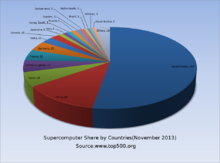
Pie chart showing share of supercomputers by countries from top 500
supercomputers as of November 2013
Since 1993, the fastest supercomputers have been ranked on the TOP500 list
according to their
LINPACK benchmark results. The
list does not claim to be unbiased or definitive, but it is a widely cited
current definition of the "fastest" supercomputer available at any given time.
This is a recent list of the computers which appeared at the top of the TOP500
list, and the "Peak speed" is given
as the "Rmax" rating. For more historical data see History
of supercomputing.
Applications of
supercomputers
The stages of supercomputer application may be summarized in the following
table:
The IBM Blue
Gene/P computer has been used to simulate a number of artificial neurons
equivalent to approximately one percent of a human cerebral cortex, containing
1.6 billion neurons with approximately 9 trillion connections. The same research
group also succeeded in using a supercomputer to simulate a number of artificial
neurons equivalent to the entirety of a rat's brain.
Modern-day weather forecasting also relies on supercomputers. The National
Oceanic and Atmospheric Administration uses
supercomputers to crunch hundreds of millions of observations to help make
weather forecasts more accurate.
In 2011, the challenges and difficulties in pushing the envelope in
supercomputing were underscored by IBM's
abandonment of the Blue
Waters petascale project.
Research and
development trends
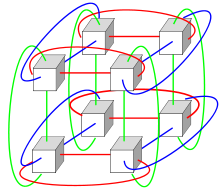
Diagram of a 3-dimensional
torus
interconnect used by
systems such as Blue Gene, Cray XT3, etc.
Given the current speed of progress, industry experts estimate that
supercomputers will reach 1 exaflops (1018,
one quintillion FLOPS) by 2018. China has stated plans to have a 1 exaflop
supercomputer online by 2018. Using
the Intel
MIC multi-core processor
architecture, which is Intel's response to GPU systems, SGI plans to achieve a
500-fold increase in performance by 2018, in order to achieve one exaflop.
Samples of MIC chips with 32 cores, which combine vector processing units with
standard CPU, have become available. The
Indian government has also stated ambitions for an exaflop-range supercomputer,
which they hope to complete by 2017.
Erik P. DeBenedictis of Sandia
National Laboratories theorizes
that a zettaflop (1021, one sextillion FLOPS)
computer is required to accomplish full weather
modeling, which could cover a two-week time span accurately.[87][not
in citation given] Such
systems might be built around 2030.
See also
Notes and references[edit]
-
Jump up^ "IBM
Blue gene announcement". 03.ibm.com. 2007-06-26.
Retrieved 2012-06-09.
-
^ Jump
up to:a b Hoffman,
Allan R.; et al. (1990). Supercomputers:
directions in technology and applications. National Academies.
pp. 35–47.ISBN 0-309-04088-4.
-
^ Jump
up to:a b Hill,
Mark Donald; Jouppi, Norman Paul; Sohi, Gurindar (1999). Readings
in computer architecture. pp. 40–49. ISBN 1-55860-539-8.
-
^ Jump
up to:a b Prodan,
Radu; Fahringer, Thomas (2007). Grid
computing: experiment management, tool integration, and scientific
workflows. pp. 1–4. ISBN 3-540-69261-4.
-
Jump up^ DesktopGrid
-
^ Jump
up to:a b Performance
Modelling and Optimization of Memory Access on Cellular Computer
Architecture Cyclops64 K
Barner, GR Gao, Z Hu, Lecture Notes in Computer Science, 2005, Volume
3779, Network and Parallel Computing, Pages 132–143
-
^ Jump
up to:a b Analysis
and performance results of computing betweenness centrality on IBM
Cyclops64 by Guangming
Tan, Vugranam C. Sreedhar and Guang R. Gao The
Journal of SupercomputingVolume 56, Number 1, 1–24 September 2011
-
Jump up^ Lemke,
Tim (May 8, 2013). "NSA
Breaks Ground on Massive Computing Center".
Retrieved December 11, 2013.
-
^ Jump
up to:a b Hardware
software co-design of a multimedia SOC platformby Sao-Jie Chen,
Guang-Huei Lin, Pao-Ann Hsiung, Yu-Hen Hu 2009 ISBN pages 70-72
-
Jump up^ The
Atlas, University of Manchester,
retrieved 21 September 2010
-
Jump up^ Lavington,
Simon (1998), A History of
Manchester Computers (2
ed.), Swindon: The British Computer Society, pp. 41–52,ISBN 978-1-902505-01-5
-
Jump up^ The
Supermen, Charles Murray, Wiley & Sons, 1997.
-
Jump up^ A
history of modern computing by
Paul E. Ceruzzi 2003 ISBN
978-0-262-53203-7 page
161 [1]
-
^ Jump
up to:a b Hannan,
Caryn (2008). Wisconsin
Biographical Dictionary. pp. 83–84. ISBN 1-878592-63-7.
-
Jump up^ John
Impagliazzo, John A. N. Lee (2004). History
of computing in education. p. 172. ISBN 1-4020-8135-9.
-
Jump up^ Richard
Sisson, Christian K. Zacher (2006). The
American Midwest: an interpretive encyclopedia. p. 1489. ISBN 0-253-34886-2.
-
Jump up^ Readings
in computer architecture by
Mark Donald Hill, Norman Paul Jouppi, Gurindar Sohi 1999 ISBN
978-1-55860-539-8 page
41-48
-
Jump up^ Milestones
in computer science and information technology by
Edwin D. Reilly 2003 ISBN
1-57356-521-0 page 65
-
^ Jump
up to:a b c Parallel
computing for real-time signal processing and control by
M. O. Tokhi, Mohammad Alamgir Hossain 2003 ISBN
978-1-85233-599-1 pages
201–202
-
Jump up^ "TOP500
Annual Report 1994". Netlib.org. 1996-10-01.
Retrieved 2012-06-09.
-
Jump up^ N.
Hirose and M. Fukuda (1997). "Numerical Wind Tunnel (NWT) and CFD
Research at National Aerospace Laboratory". Proceedings of HPC-Asia '97.
IEEE Computer Society.doi:10.1109/HPC.1997.592130.
-
Jump up^ H.
Fujii, Y. Yasuda, H. Akashi, Y. Inagami, M. Koga, O. Ishihara, M.
Syazwan, H. Wada, T. Sumimoto, Architecture and performance of the
Hitachi SR2201 massively parallel processor system, Proceedings of 11th
International Parallel Processing Symposium, April 1997, Pages 233–241.
-
Jump up^ Y.
Iwasaki, The CP-PACS project, Nuclear Physics B – Proceedings
Supplements, Volume 60, Issues 1–2, January 1998, Pages 246–254.
-
Jump up^ A.J.
van der Steen, Overview of recent supercomputers, Publication of the
NCF, Stichting Nationale Computer Faciliteiten, the Netherlands, January
1997.
-
Jump up^ Scalable
input/output: achieving system balance by
Daniel A. Reed 2003 ISBN
978-0-262-68142-1 page
182
-
Jump up^ Xue-June
Yang, Xiang-Ke Liao, et al in Journal of Computer Science and
Technology. "The
TianHe-1A Supercomputer: Its Hardware and Software". 26, Number 3.
pp. 344–351.
-
Jump up^ The
Supermen: Story of Seymour Cray and the Technical Wizards Behind the
Supercomputer by Charles
J. Murray 1997ISBN
0-471-04885-2 pages
133–135
-
Jump up^ Parallel
Computational Fluid Dyynamics; Recent Advances and Future Directions edited
by Rupak Biswas 2010 ISBN
1-60595-022-X page 401
-
Jump up^ Supercomputing
Research Advances by
Yongge Huáng 2008ISBN
1-60456-186-6 pages
313–314
-
^ Jump
up to:a b Computational
science – ICCS 2005: 5th international conference edited
by Vaidy S. Sunderam 2005 ISBN
3-540-26043-9 pages 60–67
-
Jump up^ Knight,
Will: "IBM creates world's most powerful computer",NewScientist.com
news service, June 2007
-
Jump up^ N.
R. Agida et al. (2005). "Blue
Gene/L Torus Interconnection Network | IBM Journal of Research and
Development" (PDF).Torus
Interconnection Network. 45, No 2/3 March–May 2005. p. 265.
-
Jump up^ Prickett,
Timothy (May 31, 2010). "Top
500 supers – The Dawning of the GPUs". =Theregister.co.uk.
-
Jump up^ Hans
Hacker et al in Facing the
Multicore-Challenge: Aspects of New Paradigms and Technologies in
Parallel Computing by
Rainer Keller, David Kramer and Jan-Philipp Weiss (2010). Considering
GPGPU for HPC Centers: Is It Worth the Effort?. pp. 118–121.ISBN 3-642-16232-0.
-
Jump up^ Damon
Poeter (October 11, 2011). "Cray's
Titan Supercomputer for ORNL Could Be World's Fastest". Pcmag.com.
-
Jump up^ Feldman,
Michael (October 11, 2011). "GPUs
Will Morph ORNL's Jaguar Into 20-Petaflop Titan". Hpcwire.com.
-
Jump up^ Timothy
Prickett Morgan (October 11, 2011). "Oak
Ridge changes Jaguar's spots from CPUs to GPUs". Theregister.co.uk.
-
Jump up^ Condon,
J.H. and K.Thompson, "Belle Chess Hardware", InAdvances in Computer
Chess 3 (ed.M.R.B.Clarke),
Pergamon Press, 1982.
-
Jump up^ Hsu,
Feng-hsiung (2002). Behind
Deep Blue: Building the Computer that Defeated the World Chess Champion. Princeton
University Press. ISBN 0-691-09065-3.
-
Jump up^ C.
Donninger, U. Lorenz. The
Chess Monster Hydra. Proc.
of 14th International Conference on Field-Programmable Logic and
Applications (FPL), 2004, Antwerp – Belgium, LNCS 3203, pp. 927 – 932
-
Jump up^ J
Makino and M. Taiji, Scientific
Simulations with Special Purpose Computers: The GRAPE Systems,
Wiley. 1998.
-
Jump up^ RIKEN
press release, Completion
of a one-petaflops computer system for simulation of molecular dynamics
-
Jump up^ Electronic
Frontier Foundation (1998). Cracking
DES – Secrets of Encryption Research, Wiretap Politics & Chip Design.
Oreilly & Associates Inc. ISBN 1-56592-520-3.
-
Jump up^ "NVIDIA
Tesla GPUs Power World's Fastest Supercomputer"(Press release).
Nvidia. 29 October 2010.
-
Jump up^ Balandin,
Alexander A. (October 2009). "Better
Computing Through CPU Cooling". Spectrum.ieee.org.
-
Jump up^ "The
Green 500". Green500.org.
-
Jump up^ "Green
500 list ranks supercomputers". iTnews
Australia.
-
Jump up^ Wu-chun
Feng (2003). "Making
a Case for Efficient Supercomputing | ACM Queue Magazine, Volume 1 Issue
7, 10-01-2003 doi 10.1145/957717.957772" (PDF).
-
Jump up^ "IBM
uncloaks 20 petaflops BlueGene/Q super". The Register. 2010-11-22.
Retrieved 2010-11-25.
-
Jump up^ Prickett,
Timothy (2011-07-15). "''The
Register'': IBM 'Blue Waters' super node washes ashore in August".
Theregister.co.uk. Retrieved
2012-06-09.
-
Jump up^ "HPC
Wire July 2, 2010". Hpcwire.com. 2010-07-02.
Retrieved 2012-06-09.
-
Jump up^ by
Martin LaMonica (2010-05-10). "CNet
May 10, 2010". News.cnet.com.
Retrieved 2012-06-09.
-
Jump up^ "Government
unveils world's fastest computer". CNN.
Archived from the
original on 2008-06-10.
"performing 376 million calculations for every watt of electricity
used."
-
Jump up^ "IBM
Roadrunner Takes the Gold in the Petaflop Race".
-
Jump up^ "Top500
Supercomputing List Reveals Computing Trends". "IBM... BlueGene/Q
system .. setting a record in power efficiency with a value of 1,680
Mflops/watt, more than twice that of the next best system."
-
Jump up^ "IBM
Research A Clear Winner in Green 500".
-
Jump up^ "Green
500 list". Green500.org.
Retrieved 2012-06-09.
-
^ Jump
up to:a b Encyclopedia
of Parallel Computing by David Padua 2011ISBN
0-387-09765-1 pages
426–429
-
Jump up^ Knowing
machines: essays on technical change by
Donald MacKenzie 1998 ISBN
0-262-63188-1 page
149-151
-
Jump up^ Euro-Par
2004 Parallel Processing: 10th International Euro-Par Conference 2004,
by Marco Danelutto, Marco Vanneschi and Domenico Laforenza ISBN
3-540-22924-8 pages 835
-
Jump up^ Euro-Par
2006 Parallel Processing: 12th International Euro-Par Conference,
2006, by Wolfgang E. Nagel, Wolfgang V. Walter and Wolfgang Lehner ISBN
3-540-37783-2 page
-
Jump up^ An
Evaluation of the Oak Ridge National Laboratory Cray XT3 by
Sadaf R. Alam etal International
Journal of High Performance Computing Applications February
2008 vol. 22 no. 1 52–80
-
Jump up^ Open
Job Management Architecture for the Blue Gene/L Supercomputer by Yariv
Aridor et al in Job
scheduling strategies for parallel processing by
Dror G. Feitelson 2005 ISBN ISBN
978-3-540-31024-2 pages
95–101
-
Jump up^ "Top500
OS chart". Top500.org. Retrieved
2010-10-31.
-
Jump up^ "Wide-angle
view of the ALMA correlator". ESO
Press Release. Retrieved 13
February 2013.
-
Jump up^ Folding@home:
OS Statistics. Stanford
University. Retrieved 2012-03-11.
-
Jump up^ BOINCstats:
BOINC Combined. BOINC.
Retrieved 2011-05-28Note this link will give current statistics,
not those on the date last accessed
-
Jump up^ BOINCstats:
MilkyWay@home. BOINC.
Retrieved 2011-05-28Note this link will give current statistics,
not those on the date last accessed
-
Jump up^ "Internet
PrimeNet Server Distributed Computing Technology for the Great Internet
Mersenne Prime Search". GIMPS.
Retrieved June 6, 2011.
-
^ Jump
up to:a b Kravtsov,
Valentin; Carmeli, David; Dubitzky, Werner; Orda, Ariel; Schuster,
Assaf; Yoshpa, Benny. "Quasi-opportunistic
supercomputing in grids, hot topic paper (2007)". IEEE
International Symposium on High Performance Distributed Computing.
IEEE. Retrieved 4 August 2011.
-
^ Jump
up to:a b c The
Potential Impact of High-End Capability Computing on Four Illustrative
Fields of Science and Engineering by
Committee on the Potential Impact of High-End Computing on Illustrative
Fields of Science and Engineering and National Research Council (October
28, 2008) ISBN
0-309-12485-9 page 9
-
Jump up^ Xingfu
Wu (1999). Performance
Evaluation, Prediction and Visualization of Parallel Systems.
pp. 114–117. ISBN 0-7923-8462-8.
-
^ Jump
up to:a b Dongarra,
Jack J.; Luszczek, Piotr; Petitet, Antoine (2003),"The
LINPACK Benchmark: past, present and future",Concurrency and
Computation: Practice and Experience (John
Wiley & Sons, Ltd.): 803–820
-
Jump up^ Intel
brochure – 11/91. "Directory
page for Top500 lists. Result for each list since June 1993".
Top500.org. Retrieved 2010-10-31.
-
Jump up^ "The
Cray-1 Computer System" (PDF).
Cray Research, Inc. Retrieved May 25,
2011.
-
Jump up^ Joshi,
Rajani R. (9 June 1998). "A
new heuristic algorithm for probabilistic optimization" (Subscription
required). Department of Mathematics and School of Biomedical
Engineering, Indian Institute of Technology Powai, Bombay, India.
Retrieved 2008-07-01.
-
Jump up^ "Abstract
for SAMSY – Shielding Analysis Modular System". OECD Nuclear Energy
Agency, Issy-les-Moulineaux, France.
Retrieved May 25, 2011.
-
Jump up^ "EFF
DES Cracker Source Code". Cosic.esat.kuleuven.be.
Retrieved 2011-07-08.
-
Jump up^ "Disarmament
Diplomacy: – DOE Supercomputing & Test Simulation Programme".
Acronym.org.uk. 2000-08-22. Retrieved
2011-07-08.
-
Jump up^ "China’s
Investment in GPU Supercomputing Begins to Pay Off Big Time!".
Blogs.nvidia.com. Retrieved
2011-07-08.
-
Jump up^ Kaku,
Michio. Physics
of the Future (New York:
Doubleday, 2011), 65.
-
Jump up^ "Faster
Supercomputers Aiding Weather Forecasts".
News.nationalgeographic.com. 2010-10-28.
Retrieved 2011-07-08.
-
Jump up^ Washington
Post August 8, 2011[dead
link]
-
Jump up^ Kan
Michael (2012-10-31). "China
is building a 100-petaflop supercomputer, InfoWorld, October 31, 2012".
infoworld.com. Retrieved 2012-10-31.
-
Jump up^ Agam
Shah (2011-06-20). "SGI,
Intel plan to speed supercomputers 500 times by 2018, ComputerWorld,
June 20, 2011". Computerworld.com.
Retrieved 2012-06-09.
-
Jump up^ Dillow
Clay (2012-09-18). "India
Aims To Take The "World's Fastest Supercomputer" Crown By 2017, POPSCI,
September 9, 2012". popsci.com.
Retrieved 2012-10-31.
-
Jump up^ DeBenedictis,
Erik P. (2005). "Reversible
logic for supercomputing". Proceedings
of the 2nd conference on Computing frontiers. pp. 391–402. ISBN 1-59593-019-1.
-
Jump up^ "IDF:
Intel says Moore's Law holds until 2029". Heise
Online. 2008-04-04.
The TOP500 project
ranks and details the 500 most powerful (non-distributed) computer systems
in the world. The project was started in 1993 and publishes an updated list of
the supercomputers twice
a year. The first of these updates always coincides with the International
Supercomputing Conference in
June, and the second one is presented in November at theACM/IEEE
Supercomputing Conference. The project aims to provide a reliable basis for
tracking and detecting trends in high-performance computing and bases rankings
on HPL, a portable implementation of
the high-performance LINPACK benchmark written
in Fortran for distributed-memory computers.
The TOP500 list is compiled by Hans
Meuer of the University
of Mannheim,Germany, Jack
Dongarra of the University
of Tennessee, Knoxville,
and Erich Strohmaier and Horst Simon of NERSC/Lawrence
Berkeley National Laboratory.
History
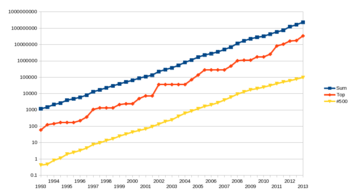
Rapid growth of supercomputers performance, based on data from
top500.org site. The logarithmic
y-axis
shows performance in GFLOPS. The red line denotes the fastest
supercomputer in the world at the time. The yellow line denotes
supercomputer no. 500 on TOP500 list. The dark blue line denotes
the total combined performance of supercomputers on TOP500 list.
In the early 1990s, a
new definition of supercomputer was needed to produce meaningful statistics.
After experimenting with metrics based on processor count in 1992, the idea
was born at the University
of Mannheim to use a detailed
listing of installed systems as the basis. Early 1993 Jack
Dongarrawas persuaded to join the project with his LINPACK
benchmark. A first test version was produced in May 1993, partially
based on data available on the Internet, including the following sources:
- "List of the World's Most Powerful
Computing Sites" maintained by Gunter Ahrendt
-
David Kahaner, the director of the Asian
Technology Information Program (ATIP), in
1992 had published a report titled "Kahaner
Report on Supercomputer in Japan" which
had an immense amount of data.
The information from
those sources was used for the first two lists. Since June 1993, the TOP500
is produced bi-annually based on site and vendor submissions only.
Since 1993, performance
of the #1 ranked position has steadily grown in agreement with Moore's
law, doubling roughly every 14 months. As of June 2013, the fastest
system, the Tianhe-2 with
Rpeak of 54.9024 PFlop/s,
is over 419,102 times faster than the fastest system in November 1993, the Connection
Machine CM-5/1024 (1024
cores) with Rpeak of 131.0 GFlop/s.
Architecture and operating systems
As of November 2013,
TOP500 supercomputers are overwhelmingly based on x86-64 CPUs (Intel EMT64 and AMD AMD64 instruction
set architecture), with the RISC-based Power
Architecture used by IBM
POWER microprocessors, and SPARC making
up the remainder. Prior to the ascendance of 32-bit x86 and
later 64-bit x86-64 in
the early 2000s,
a variety of RISC processor
families made up the majority of TOP500 supercomputers, including RISC architectures
such as SPARC, MIPS, PA-RISC and Alpha.
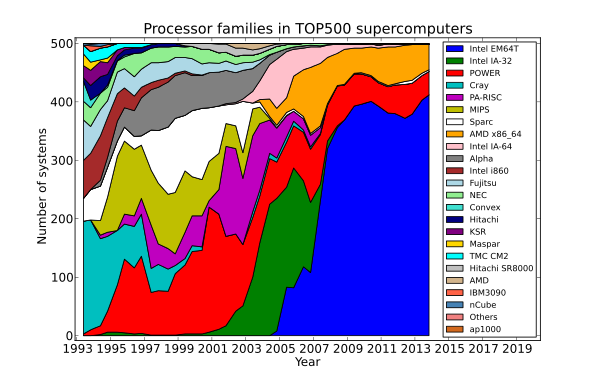
Share of processor architecture families in TOP500
supercomputers by time trend.
Top 10 ranking
Top 10 positions of the 42nd TOP500
on November 18, 2013
|
1 |
33.863
54.902 |
Tianhe-2 |
NUDT
Xeon E5–2692 + Xeon
Phi 31S1P, TH
Express-2 |
NUDT |
National Supercomputing Center in Guangzhou
 China,
2013 China,
2013 |
Linux (Kylin) |
|
2 |
17.590
27.113 |
Titan |
Cray XK7
Opteron 6274 + Tesla
K20X, Cray Gemini Interconnect |
Cray |
Oak Ridge National Laboratory
 United
States, 2012 United
States, 2012 |
Linux (CLE, SLESbased) |
|
3 |
17.173
20.133 |
Sequoia |
Blue Gene/Q
PowerPC A2, Custom |
IBM |
Lawrence Livermore National Laboratory
 United
States, 2013 United
States, 2013 |
Linux (RHEL andCNK) |
|
4 |
10.510
11.280 |
K computer |
RIKEN
SPARC64 VIIIfx, Tofu |
Fujitsu |
RIKEN
 Japan,
2011 Japan,
2011 |
Linux |
|
5 |
8.586
10.066 |
Mira |
Blue Gene/Q
PowerPC A2, Custom |
IBM |
Argonne National Laboratory
 United
States, 2013 United
States, 2013 |
Linux (RHEL andCNK) |
|
6 |
6.271
7.779 |
Piz Daint |
Cray XC30
Xeon E5–2670 + Tesla
K20X, Aries |
Cray Inc. |
Swiss National Supercomputing Centre
 Switzerland,
2013 Switzerland,
2013 |
Linux (CLE) |
|
7 |
5.168
8.520 |
Stampede |
PowerEdge C8220
Xeon E5–2680 + Xeon
Phi, Infiniband |
Dell |
Texas Advanced Computing Center
 United
States, 2013 United
States, 2013 |
Linux |
|
8 |
5.008
5.872 |
JUQUEEN |
Blue Gene/Q
PowerPC A2, Custom |
IBM |
Forschungszentrum Jülich
 Germany,
2013 Germany,
2013 |
Linux (RHEL andCNK) |
|
9 |
4.293
5.033 |
Vulcan |
Blue Gene/Q
PowerPC A2, Custom |
IBM |
Lawrence Livermore National Laboratory
 United
States, 2013 United
States, 2013 |
Linux (RHEL andCNK) |
|
10 |
2.897
3.185 |
SuperMUC |
iDataPlex DX360M4
Xeon E5–2680, Infiniband |
IBM |
Leibniz-Rechenzentrum
 Germany,
2012 Germany,
2012 |
Linux |
Legend:
- Rank – Position within the
TOP500 ranking. In the TOP500 List table, the computers are ordered
first by their Rmax value. In the case of equal performances (Rmax
value) for different computers, the order is by Rpeak. For sites that
have the same computer, the order is by memory size and then
alphabetically.
- Rmax – The highest score
measured using the LINPACK
benchmark suite. This is
the number that is used to rank the computers. Measured in quadrillions of floating
point operations per second,
i.e. petaflops.
- Rpeak – This is the theoretical
peak performance of the system. Measured in Pflops.
- Name – Some supercomputers are
unique, at least on its location, and are therefore christened by its
owner.
- Computer – The computing
platform as it is marketed.
- Processor cores – The number of
active processor
cores actively used
running LINPACK. After this figure is the processor
architectureof the cores named. If the interconnect between
computing nodes is of interest, it's also included here.
- Vendor – The manufacturer of
the platform and hardware.
- Site – The name of the facility
operating the supercomputer.
- Country – The country in which
the computer is situated.
- Year – The year of
installation/last major update.
- Operating system – The
operating system that the computer uses.
Other rankings
Top countries
Numbers below represent
the number of computers in the TOP500 that are in each of the listed
countries.
Systems ranked
#1 since 1993
- NUDT Tianhe-2A (
 China,
June 2013 - present)
China,
June 2013 - present)
- Cray Titan (
 United
States, November 2012 - June 2013)
United
States, November 2012 - June 2013)
- IBM Sequoia Blue
Gene/Q (
 United
States, June 2012 – November 2012)
United
States, June 2012 – November 2012)
- Fujitsu K
computer (
 Japan,
June 2011 – June 2012)
Japan,
June 2011 – June 2012)
- NUDT Tianhe-1A (
 China,
November 2010 – June 2011)
China,
November 2010 – June 2011)
- Cray Jaguar (
 United
States, November 2009 – November 2010)
United
States, November 2009 – November 2010)
- IBM Roadrunner (
 United
States, June 2008 – November 2009)
United
States, June 2008 – November 2009)
- IBM Blue
Gene/L (
 United
States, November 2004 – June 2008)
United
States, November 2004 – June 2008)
- NEC Earth
Simulator (
 Japan,
June 2002 – November 2004)
Japan,
June 2002 – November 2004)
- IBM ASCI
White (
 United
States, November 2000 – June 2002)
United
States, November 2000 – June 2002)
- Intel ASCI
Red (
 United
States, June 1997 – November 2000)
United
States, June 1997 – November 2000)
- Hitachi CP-PACS (
 Japan,
November 1996 – June 1997)
Japan,
November 1996 – June 1997)
- Hitachi SR2201 (
 Japan,
June 1996 – November 1996)
Japan,
June 1996 – November 1996)
- Fujitsu Numerical
Wind Tunnel (
 Japan,
November 1994 – June 1996)
Japan,
November 1994 – June 1996)
- Intel Paragon
XP/S140 (
 United
States, June 1994 – November 1994)
United
States, June 1994 – November 1994)
- Fujitsu Numerical
Wind Tunnel (
 Japan,
November 1993 – June 1994)
Japan,
November 1993 – June 1994)
- TMC CM-5 (
 United
States, June 1993 – November 1993)
United
States, June 1993 – November 1993)
Number of systems
By number of systems as
of November 2013:
Large machines
not on the list
A few machines that have
not been benchmarked are not eligible for the list: such as NCSA's Blue
Waters. Additionally purpose-built machines that are not capable or do
not run the benchmark are not included: such as RIKEN
MDGRAPE-3.
See also[edit]
References
External links
China Still Has The World's Fastest Supercomputer
Earlier this week, the Top500 organization
announced its semi-annual list of the Top
500 supercomputers in
the world. And for the second year in a row, China’s Tianhe-2 is the
world’s fastest by a long shot, maintaining its performance of 33.86
petaflop/s (quadrillions of calculations per second) on the
standardized benchmark attached to every supercomputer on the list.
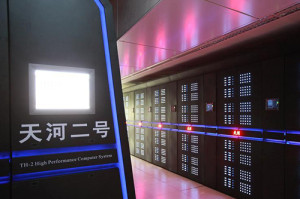
The
Tiahne-2 supercomputer. (Credit: National University of Defense
Technology)
In fact, the top 5 fastest supercomputers on the November 2013 list
are the same as the top 5 fastest supercomputers on the June 2013
list. The second fastest supercomputer in the world is Cray’s Titan
supercomputer at the Oak Ridge National Laboratory.
Rounding out the top five are IBM’s Sequoia supercomputer, RIKEN’s K
Computer in Japan, and IBM’s Mira supercomputer at the Argonne
National Laboratory.
The stability of the the top five is unique in the past few years,
which has seen several different computers being named the fastest,
while others moved down and up the ranks.
The Tianhe-2 was built by the National
University of Defense Technology in China. It has a total of
3,120,000 Intel processing cores, but also features a number of
Chinese built components and runs on a version of Linux
called Kylin, which was natively developed by the NUDT.
The newest entry into the top ten supercomputer list is number 6 on
the list, Piz Daint, a Cray system that has been installed at Swiss
National Supercomputing Centre. Piz Daint is now the fastest
supercomputer in Europe. It’s also the most energy efficient system
in the Top 10. That’s something to note, because one of the biggest
constraints on supercomputing is the sheer amount of power needed to
operate the systems.
“In the top 10, computers might hit a high mark,” Kai Dupke, a
senior product manager at SUSE Linux told me in a conversation about
the supercomputer race. “But in the usual operation, they operate
more slowly simply because it’s too expensive to run on full speed.”
Although China is still home to the world’s fastest supercomputer,
the United States continues to be the leader in high performance
computing. In June, the United States had 253 of the top 500 fastest
computers. In the November list, it has 265. China, on the other
hand, has 63 computers on the list, down from the 65 it had in June.
Follow me on Twitter or Facebook.
Read my Forbes blog here.
That new supercomputer is not your friend
China reclaims the fastest computer in the world prize. Get ready for even
better surveillance
ANDREW LEONARD
We learned this week that China has the fastest
supercomputer in the world, by a long shot. The Tianhe-2 is almost
twice as speedy as the previous record holder,
a U.S.-made Cray Titan.
Such news, by itself, isn’t particularly amazing.
It’s not even the first time a Chinese supercomputer has held the top
ranking. The Tianhe-1 grabbed the pole position in November 2010 and held it
until June 2011. Previously, Japan and the United States had traded
places since 1993. Supercomputing speed
follows roughly the same trajectory as Moore’s Law — it doubles about every
14 months. There will always be new contenders for the throne.
But this month, there’s a new context for news
about the debut of ever more powerful supercomputers. Consider the first
comment left on Reddit to a thread announcing the
exploits of Tianhe-2:
This would be a pretty awesome tool for churning through millions of
phone records and digital copies of people’s online data.
Haha. Funny. But not really. The not-so-subtle
implication of the constant expansion of supercomputing capacity is that, to
borrow a quote from Intel’s Raj Hazra that appeared in the
New York Times, “the insatiable need for
computing is driving this.” Big Data wants Big Computers.
Cyber Espionage: The Chinese Threat
Experts at the highest levels of government say it's the biggest
threat facing American business today. Hackers are stealing valuable
trade secrets, intellectual property and confidential business
strategies.
Government officials are calling it the biggest threat to America's
economic security. Cyber spies hacking into U.S. corporations' computer
networks are stealing valuable trade secrets, intellectual property data
and confidential business strategies. The biggest aggressor? China.
CNBC's David Faber investigates this new wave of espionage, which
experts say amounts to the largest transfer of wealth ever seen
—draining America of its competitive advantage and its economic edge.
Unless corporate America wakes up and builds an adequate defense
strategy, experts say it may be too late.
The Danger of Mixing Cyberespionage With Cyberwarfare
China has recently been accused of intense spying activity
in cyberspace, following claims that the country uses cyber
tactics to gain access to military and technological secrets
held by both foreign states and corporations. In this
context, the rhetoric of cyberwar has also raised its head.
Experts are questioning whether we are already at war with
China.
But a danger lies at the heart of the cyberwar rhetoric.
Declaring war, even cyberwar, has always had serious
consequences. Since war is acknowledged as the most severe
threat to the survival and well-being of society, war
rhetoric easily feeds an atmosphere of fear, provokes a rise
in the emergency level and instigates counter-measures. It
may also lead to an intensified cyber arms race.
It needs to be remembered that
cyber espionage does not equate to cyber warfare - and in
fact making such a link is completely unjustifiable.
Cyber espionage is an activity multiple actors resort to in
the name of security, business, politics or technology. It
is not inherently military. Espionage is finding information
that ought to remain secret and as such, may be carried out
for a range of different reasons and for varying lengths of
time.
Cyber espionage is an activity multiple actors resort to in the name of
security, business, politics or technology. It is not inherently
military. Espionage is finding information that ought to remain secret
and as such, may be carried out for a range of different reasons and for
varying lengths of time.
Conducting effective cyber espionage campaigns may in fact take years,
and results can be uncertain. However engaging in long-lasting cyberwar
activity is simply not sustainable as the costs of warfare are high, and
the motives very different; gaining information is never the prime
motive. War is waged in order to re-engineer the opposing society to
support one’s interests and values. This holds true for cyberwar as
well.
But that's not to say that the two concepts aren't inter-linked. Cyber
espionage can be utilised in warfare for preparing for war, as part of
intelligence efforts, and for preparing for peace. Plus, a long-lasting
spying campaign that eventually becomes detected may lead to war if it
is interpreted to justify pre-emptive or preventive actions.
However, the probability of cyberwar in the near future is low. What we
should be more concious of is the use of cyber in conventional
conflicts. Cyber capabilities are now classified as weapons; they are a
fifth dimension of warfare -- in addition to land, sea, air and space --
and whilst it’s unlikely future battles will be completely online, it is
difficult to imagine future wars or conflicts without cyber activities.
But even if the concept of war has become vague, espionage should be
regarded as a seperate activity in its own right. For actions to qualify
as war they should cause massive human loss and material damage --
cyberespionage does not do this. For the majority, there is little to be
gained from confusing cyberespionage with cyberwarfare, yet the
potential losses in the form of increasingly restricted freedom and
curtailed private space may be substantial.
The continued rapid growth of processing power brings with it enormous privacy
implications.Applications
such as facial recognition require massive computing power. Things that
aren’t quite possible today, like waving your phone at a stranger and
identifying them with NSA-like precision, will be child’s play tomorrow.
Encryption standards that we think can resist the toughest attacks right
now may wilt before the power of what’s around the corner. I used to
hear about new supercomputers and think about the inexorable march
forward into the science fiction future. Now I just think, oh great: the architecture
of surveillance just
got more fortified.
Read more: http://insights.wired.com/profiles/blogs/the-danger-of-mixing-cyberespionage-with-cyberwarfare#ixzz30BOzO65c
Follow us: @Wiredinsights
on Twitter | InnovationInsights
on Facebook
THE SECRET WAR
INFILTRATION. SABOTAGE. MAYHEM. FOR YEARS, FOUR-STAR GENERAL KEITH
ALEXANDER HAS BEEN BUILDING A SECRET ARMY CAPABLE OF LAUNCHING
DEVASTATING CYBERATTACKS. NOW
IT’S READY TO UNLEASH HELL.
INSIDE FORT MEADE, Maryland, a top-secret city
bustles. Tens of thousands of people move through more than
50 buildings—the city has its own post office, fire
department, and police force. But as if designed by Kafka,
it sits among a forest of trees, surrounded by electrified
fences and heavily armed guards, protected by antitank
barriers, monitored by sensitive motion detectors, and
watched by rotating cameras. To block any telltale
electromagnetic signals from escaping, the inner walls of
the buildings are wrapped in protective copper shielding and
the one-way windows are embedded with a fine copper mesh.
This is the undisputed domain of General Keith Alexander, a
man few even in Washington would likely recognize. Never
before has anyone in America’s intelligence sphere come
close to his degree of power, the number of people under his
command, the expanse of his rule, the length of his reign,
or the depth of his secrecy. A four-star Army general, his
authority extends across three domains: He is director of
the world’s largest intelligence service, the National
Security Agency; chief of the Central Security Service; and
commander of the US Cyber Command. As such, he has his own
secret military, presiding over the Navy’s 10th Fleet, the
24th Air Force, and the Second Army.
Alexander runs the nation’s cyberwar efforts, an empire he
has built over the past eight years by insisting that the
US’s inherent vulnerability to digital attacks requires him
to amass more and more authority over the data zipping
around the globe. In his telling, the threat is so
mind-bogglingly huge that the nation has little option but
to eventually put the entire civilian Internet under his
protection, requiring tweets and emails to pass through his
filters, and putting the kill switch under the government’s
forefinger. “What we see is an increasing level of activity
on the networks,” he said at a recent security conference in
Canada. “I am concerned that this is going to break a
threshold where the private sector can no longer handle it
and the government is going to have to step in.”
In its tightly controlled public relations, the NSA has
focused attention on the threat of cyberattack against the
US—the vulnerability of critical infrastructure like power
plants and water systems, the susceptibility of the
military’s command and control structure, the dependence of
the economy on the Internet’s smooth functioning. Defense
against these threats was the paramount mission trumpeted by
NSA brass at congressional hearings and hashed over at
security conferences.
But there is a flip side to this equation that is rarely
mentioned: The military has for years been developing
offensive capabilities, giving it the power not just to
defend the US but to assail its foes. Using so-called
cyber-kinetic attacks, Alexander and his forces now have the
capability to physically destroy an adversary’s equipment
and infrastructure, and potentially even to kill.
Alexander—who declined to be interviewed for this
article—has concluded that such cyberweapons are as crucial
to 21st-century warfare as nuclear arms were in the 20th.
And he and his cyberwarriors have already launched their
first attack. The cyberweapon that came to be known as
Stuxnet was created and built by the NSA in partnership with
the CIA and Israeli intelligence in the mid-2000s. The first
known piece of malware designed to destroy physical
equipment, Stuxnet was aimed at Iran’s nuclear facility in
Natanz. By surreptitiously taking control of an industrial
control link known as a Scada (Supervisory Control and Data
Acquisition) system, the sophisticated worm was able to
damage about a thousand centrifuges used to enrich nuclear
material.
The success of this sabotage came to light only in June
2010, when the malware spread to outside computers. It was
spotted by independent security researchers, who identified
telltale signs that the worm was the work of thousands of
hours of professional development. Despite headlines around
the globe, officials in Washington have never openly
acknowledged that the US was behind the attack. It wasn’t
until 2012 that anonymous sources within the Obama
administration took credit for it in interviews with
The New York Times.
But Stuxnet is only the beginning. Alexander’s agency has
recruited thousands of computer experts, hackers, and
engineering PhDs to expand US offensive capabilities in the
digital realm. The Pentagon has requested $4.7 billion for
“cyberspace operations,” even as the budget of the CIA and
other intelligence agencies could fall by $4.4 billion. It
is pouring millions into cyberdefense contractors. And more
attacks may be planned.

“WE JOKINGLY REFERRED TO HIM AS EMPEROR ALEXANDER, BECAUSE
WHATEVER KEITH WANTS, KEITH GETS.”
Inside the government, the general is regarded with a
mixture of respect and fear, not unlike J. Edgar Hoover,
another security figure whose tenure spanned multiple
presidencies. “We jokingly referred to him as Emperor
Alexander—with good cause, because whatever Keith wants,
Keith gets,” says one former senior CIA official who agreed
to speak on condition of anonymity. “We would sit back
literally in awe of what he was able to get from Congress,
from the White House, and at the expense of everybody else.”
Now 61, Alexander has said he plans to retire in 2014; when
he does step down he will leave behind an enduring legacy—a
position of far-reaching authority and potentially
Strangelovian powers at a time when the distinction between
cyberwarfare and conventional warfare is beginning to blur.
A recent Pentagon report made that point in dramatic terms.
It recommended possible deterrents to a cyberattack on the
US. Among the options: launching nuclear weapons.

FROM
http://www.wired.com/2013/06/general-keith-alexander-cyberwar/all/
|
THIS IS WHERE I POST WHAT I'M DOING AND THINKING
BLOG INDEX 2011
BLOG INDEX 2012 - page 1
JANUARY THRU APRIL 2012
BLOG INDEX 2012 - PAGE 2
MAY THRU AUGUST 2012
BLOG INDEX 2012 - PAGE 3
SEPTEMBER THRU DECEMBER
BLOG INDEX 2013
JAN, FEB, MAR, APR. 2013
BLOG INDEX - PAGE 2 - 2013
MAY, JUNE, JULY, AUGUST 2013
BLOG INDEX - PAGE 3 - 2013
SEPT, OCT, NOV, DEC, 2013
BLOG INDEX - PAGE 4 - 2014
JAN., FEB., MAR., APR. 2014
|

